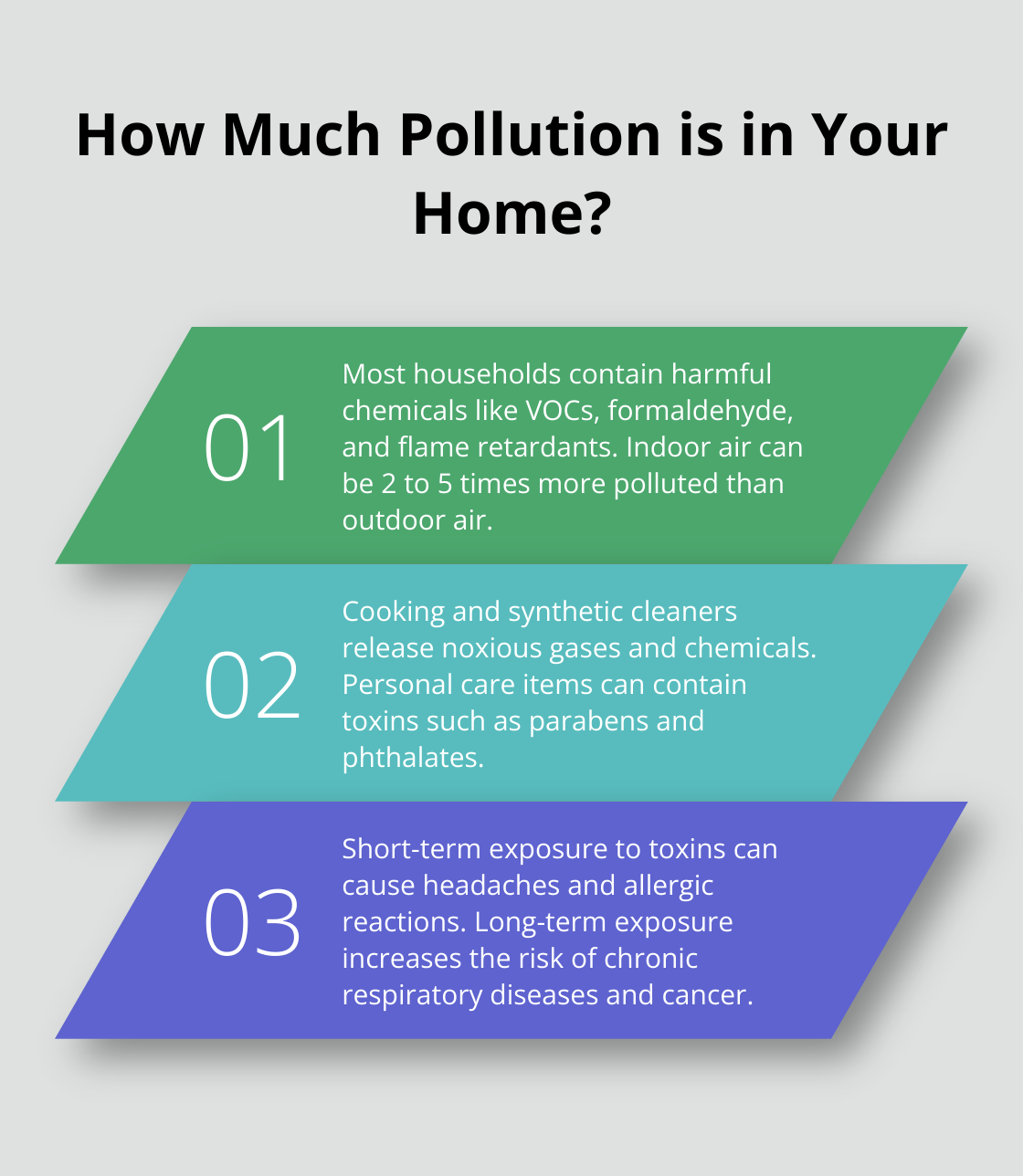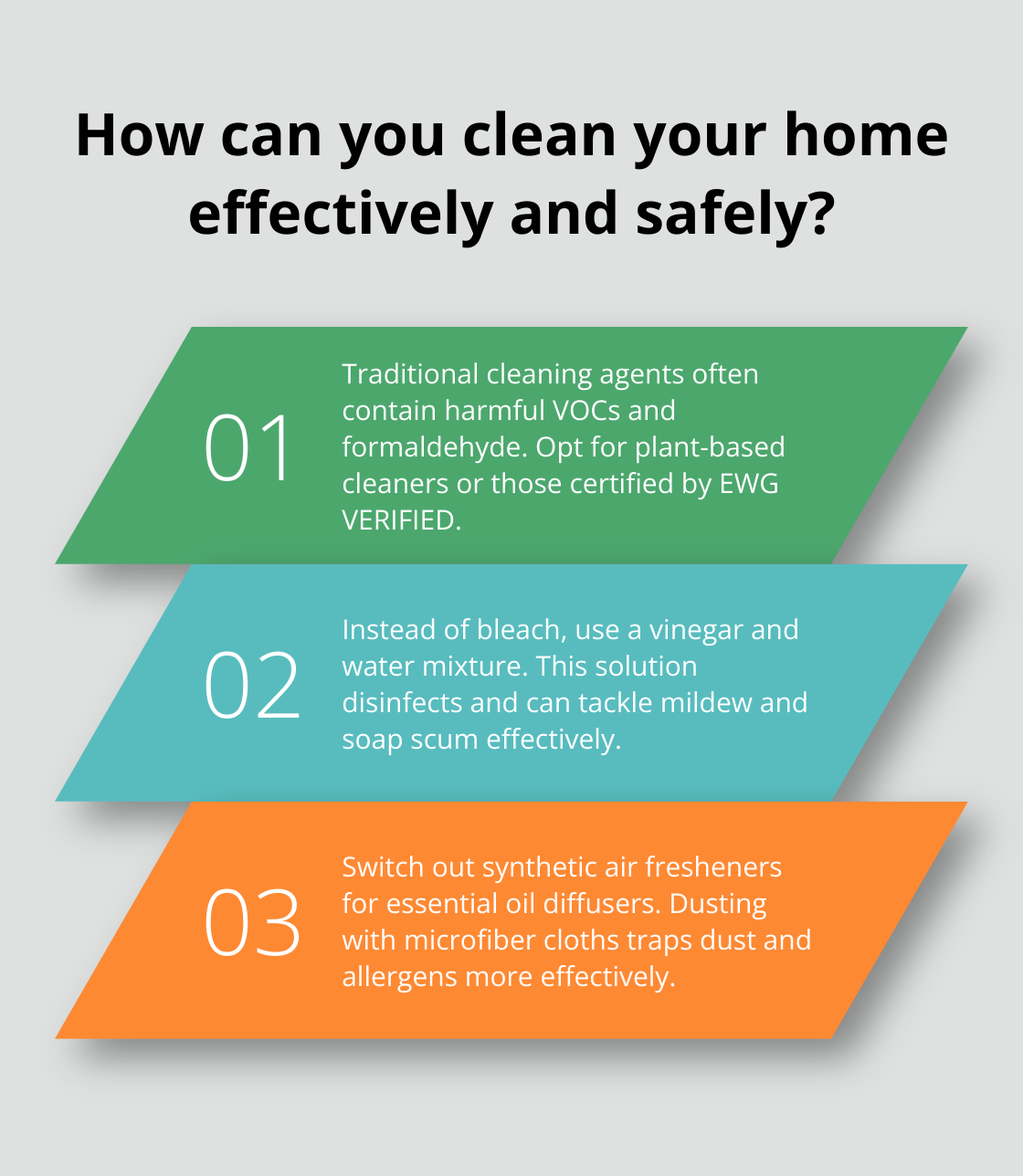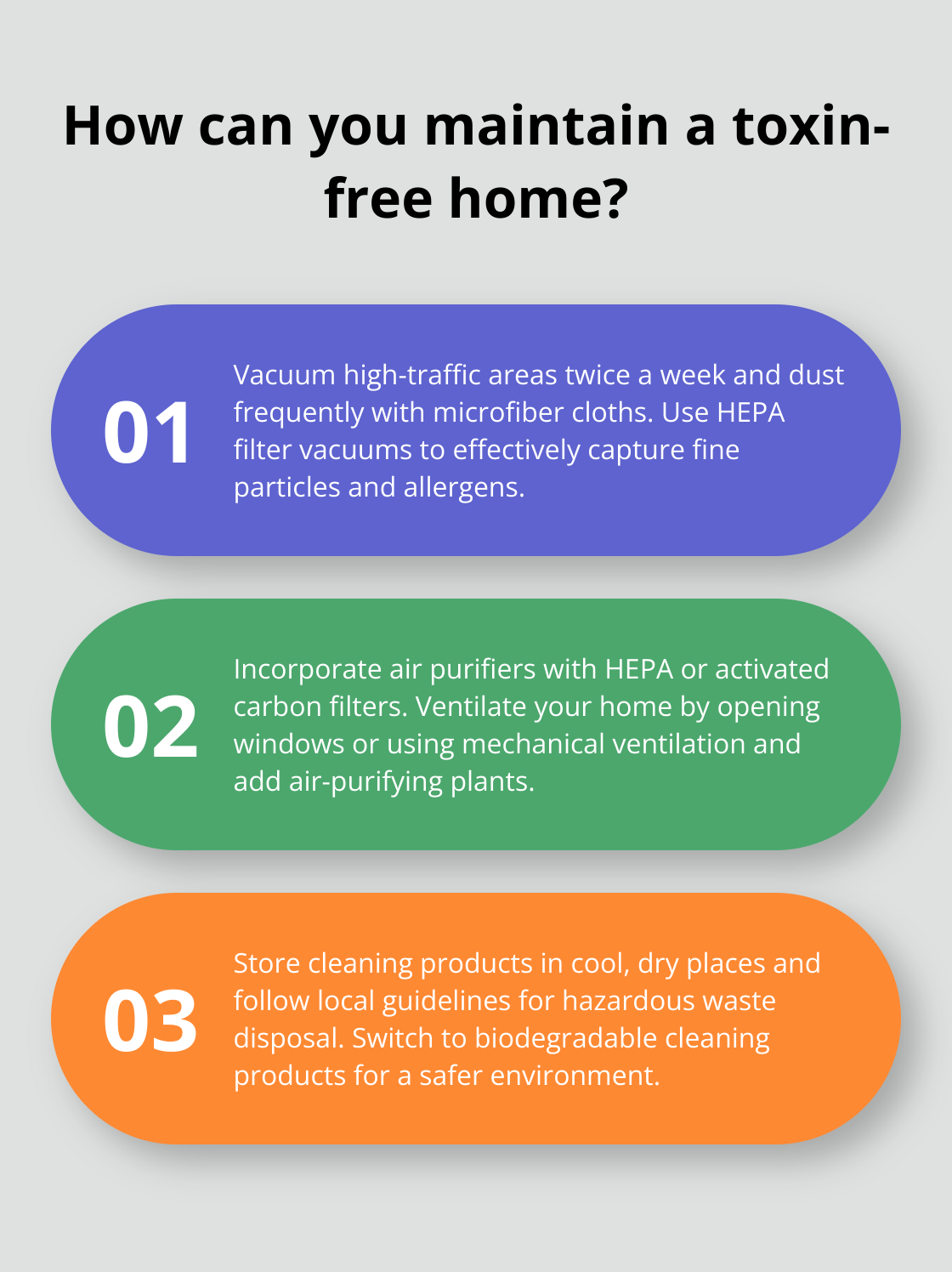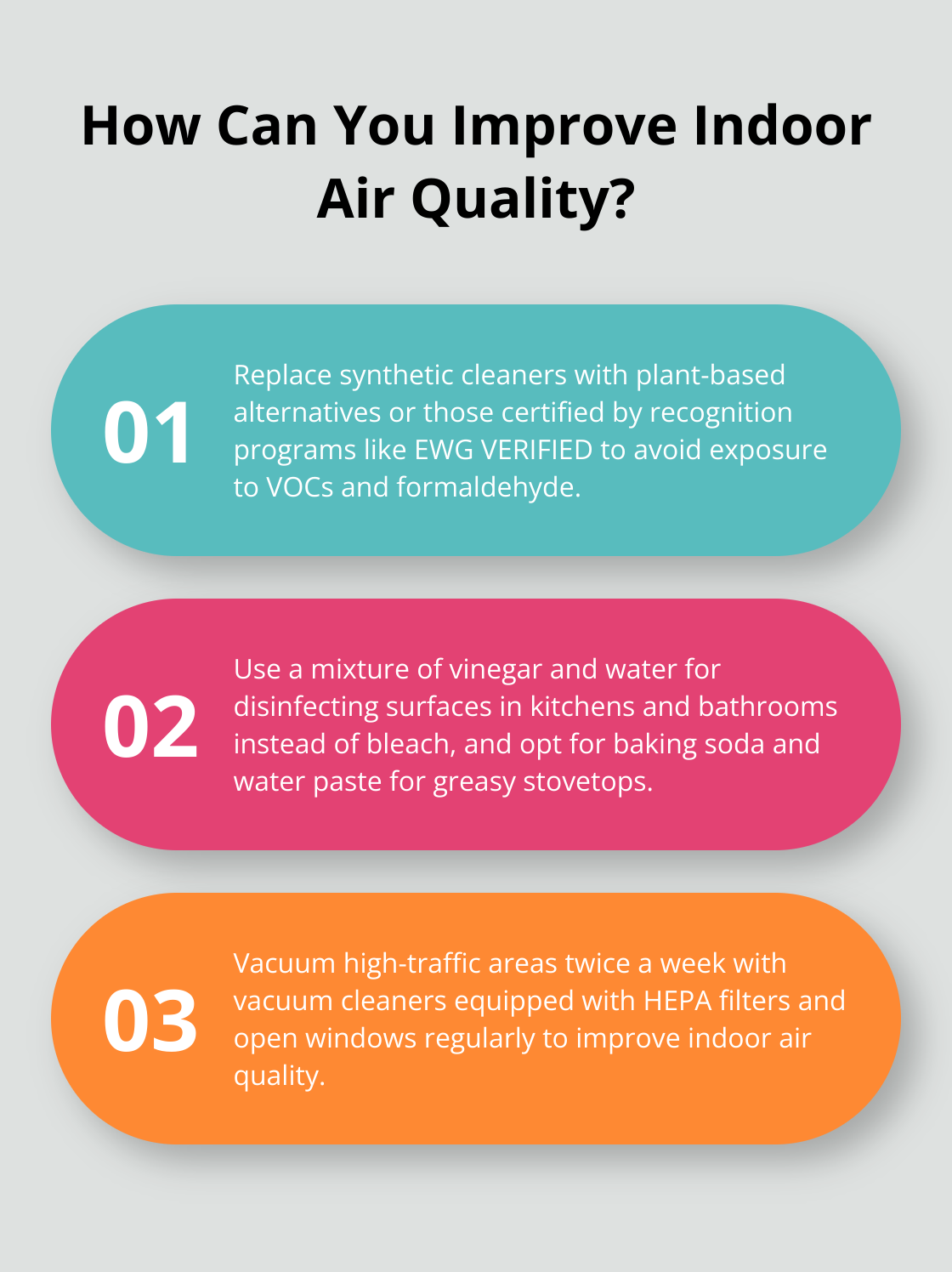Keeping your home toxin-free is essential for a healthy living environment.
At The A Team Cleaning Services, we believe that understanding and eliminating household toxins can significantly improve your well-being.
Let’s explore effective strategies to detox your home and maintain a safer, cleaner space.
How to Identify Home Toxins
Understanding the various sources of toxins in your home is the first step towards a safer living environment. Here’s how you can pinpoint and address these hidden dangers.
Common Household Toxins
Most households contain a surprising array of harmful chemicals. Common culprits include volatile organic compounds (VOCs) found in paints, cleaning products, and air fresheners. Formaldehyde is another frequent guest, lurking in furniture, pressed-wood products, and even some textiles. Flame retardants, used in electronics and upholstery, can also release harmful particles over time.

One study by the Environmental Working Group (EWG) found that indoor air can be two to five times more polluted than outdoor air, often due to these substances. Knowing what to look for is crucial.
Sources of Indoor Pollution
Indoor pollution comes from various everyday activities and products. Cooking can release noxious gases and particles, especially if using non-stick cookware with plasticized coatings. Synthetic cleaners contribute highly to poor indoor air quality due to their harsh chemicals. Even personal care items like shampoos and lotions can contain dangerous chemicals like parabens and phthalates.
Regular household items can be significant pollution sources. Replace plastic food storage containers with glass or stainless steel to avoid chemicals like BPA and phthalates. Also, consider upgrading to natural fiber rugs instead of synthetic ones to cut down on VOC exposure.
Health Effects of Home Toxins
Exposure to household toxins has profound health impacts. Short-term effects can include headaches, dizziness, and allergic reactions. Long-term exposure may lead to more severe conditions such as respiratory issues, reproductive problems, and even certain cancers.
A study published in the American Journal of Respiratory and Critical Care Medicine indicated that long-term exposure to indoor pollutants significantly increases the risk of developing chronic respiratory diseases. Children and older adults are particularly vulnerable to these health risks.
Being informed about these toxins and making conscious changes in your home environment, like swapping out conventional cleaners for green alternatives, can lead to a healthier living space.
By tackling the sources and understanding the impacts, you can significantly reduce toxins in your home, creating a safer environment for you and your family.
Effective Cleaning Strategies
Switching to non-toxic cleaning products is one of the most impactful changes you can make in your home. Traditional cleaning agents often contain VOCs, formaldehyde, and other harmful components. Opt for plant-based cleaners or those certified by recognition programs like EWG VERIFIED. These alternatives clean just as effectively, without compromising your health.
Cleaning the Kitchen and Bathroom
The kitchen and bathroom are hotspots for toxins due to frequent use of strong cleaners. Instead of bleach, which releases harmful gases, use a mixture of vinegar and water. It’s just as effective for disinfecting surfaces and can even tackle mildew and soap scum. For greasy stovetops, a paste of baking soda and water works wonders without the need for commercial degreasers.
Living Areas and Bedrooms
In living areas and bedrooms, switch out synthetic air fresheners for essential oil diffusers or simply open windows to improve air quality. Dusting with microfiber cloths is a more effective and safer method than using chemical-laden sprays. These cloths trap dust and allergens rather than spreading them around.
Safe Cleaning Equipment
Invest in tools designed to minimize exposure to toxins. Use vacuum cleaners equipped with HEPA filters to capture tiny particles that ordinary vacuums miss. Brands like Dyson and Shark harness this technology effectively, reducing dust and allergen levels significantly.

By integrating these strategies, you effectively detox your home, fostering a healthier environment. This approach ensures you’re not exposing your family to unnecessary risks while maintaining a clean living space. For more tips on creating a toxin-free home, consider eco-friendly cleaning tips that align with your goals.
Maintaining a Toxin-Free Home
Regular home maintenance is key to keeping your living space free from harmful toxins. From consistent cleaning routines to smart air purification methods, each step plays a crucial role in ensuring a safe environment.
Establish Regular Cleaning Schedules
Consistency is essential in reducing the buildup of dust, allergens, and toxic substances. Aim to vacuum high-traffic areas twice a week, particularly if you have pets. Use vacuums with HEPA filters to capture fine particles and allergens effectively. Dust surfaces frequently with microfiber cloths to trap dust rather than redistribute it.

For a deeper clean, consider targeting one room each week. This approach divides the burden and ensures thorough attention to spaces that might otherwise be neglected. Bedrooms should be cleaned to minimize allergens that impact sleep quality, while kitchens and bathrooms need regular disinfecting due to moisture and food prep activities.
Optimize Air Quality
Indoor air can be significantly more polluted than outdoor air. One effective strategy is to incorporate air purifiers equipped with HEPA or activated carbon filters. Devices from brands like Dyson and Honeywell have shown impressive results in reducing airborne particles and contaminants.
Ventilation is another critical factor. Open windows regularly to allow fresh air to circulate and dilute indoor pollutants. For those living in areas with high outdoor pollution, using mechanical ventilation like exhaust fans can help maintain air quality without compromising safety.
Adding indoor plants known for their air-purifying properties can also help. Plants such as spider plants, peace lilies, and Boston ferns absorb toxins like formaldehyde and benzene, contributing to a fresher environment.
Manage and Dispose of Chemicals Safely
Careful storage and disposal of household chemicals are vital in maintaining a toxin-free home. Store cleaning products in a cool, dry place out of reach of children and pets. Use original containers to avoid chemical reactions from inappropriate storage.
When disposing of hazardous materials, follow local guidelines for hazardous waste disposal. Never pour chemicals down the drain, as this can harm water supplies and ecosystems. Utilize community hazardous waste collection events or drop-off locations.
Switching to biodegradable cleaning products can significantly reduce hazardous waste in your home. Products without VOCs, parabens, or synthetic fragrances are safer for both your family and the environment. For sustainable options, explore biodegradable cleaning products.
Maintaining a toxin-free home takes consistent effort but has a substantial payoff in terms of health and well-being. Through regular cleaning, optimizing air quality, and mindful chemical management, you create a safer and healthier living environment for your family.
Wrapping Up
Detoxifying your home offers numerous benefits. By reducing exposure to harmful chemicals, you can improve air quality, protect your health, and create a more comfortable living environment. The effects might include fewer allergy symptoms, better respiratory health, and an overall sense of well-being.

Consistency in cleaning is vital for maintaining these benefits. Establishing regular schedules and using non-toxic products ensures your home remains a safe haven. Switching to tools like vacuum cleaners with HEPA filters, and integrating natural solutions like essential oil diffusers, can make a significant difference.
Regular cleaning and mindful chemical management contribute to a healthier living space, reducing the risk of long-term health issues. Maintaining air quality by incorporating air-purifying plants and using air purifiers further enhances your home environment.
For those seeking comprehensive cleaning solutions, The A Team offers professional-grade products and tailored cleaning plans. Our services ensure a high standard of cleanliness, promoting a healthier home or workspace.
Start your journey to a toxin-free home today and experience the positive impact on your health and well-being. For more detailed tips and guides, you can visit our blogs on eco-friendly cleaning and sustainable cleaning practices.
